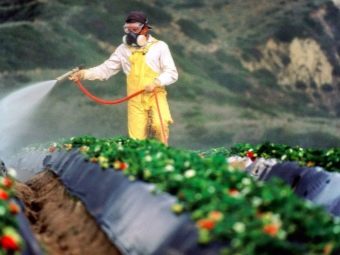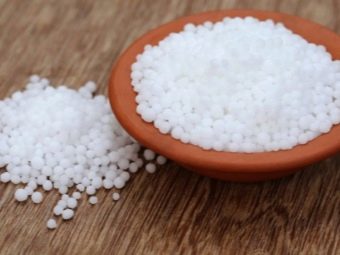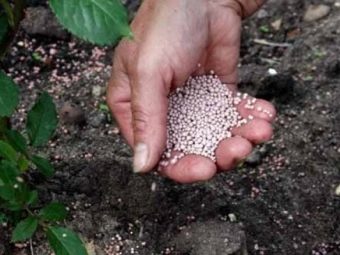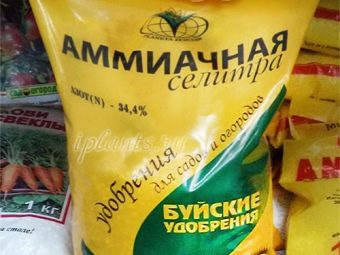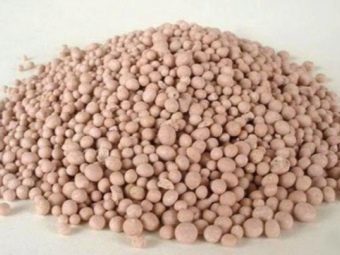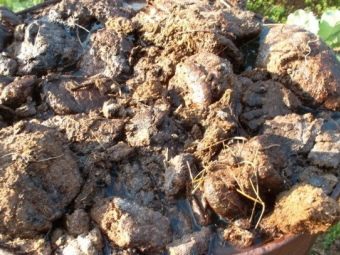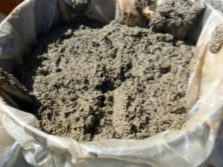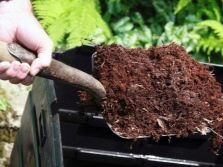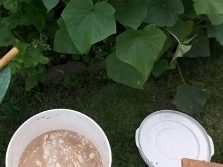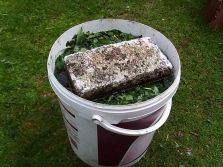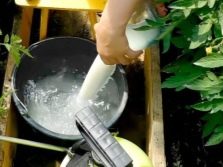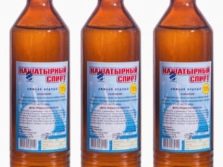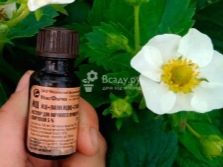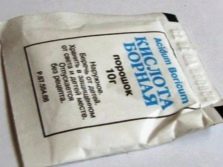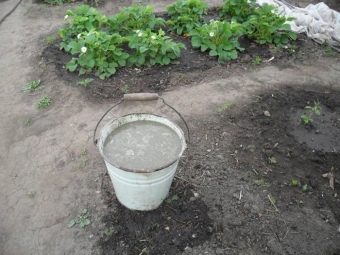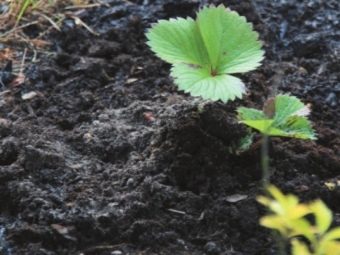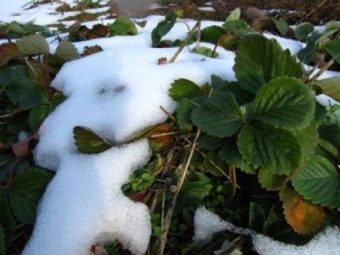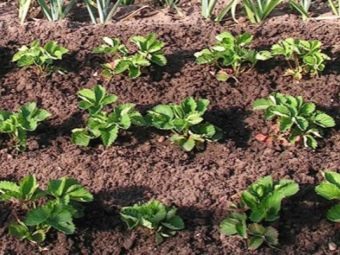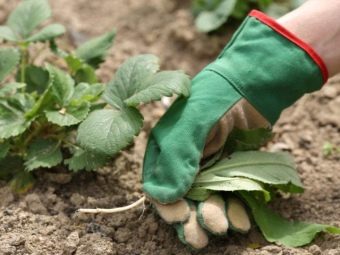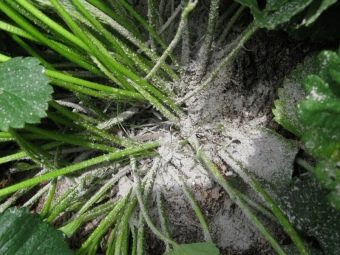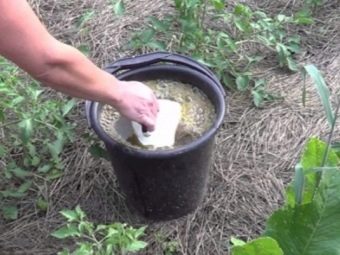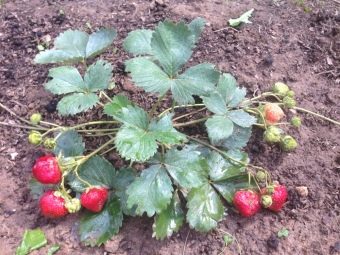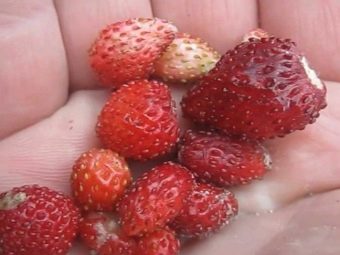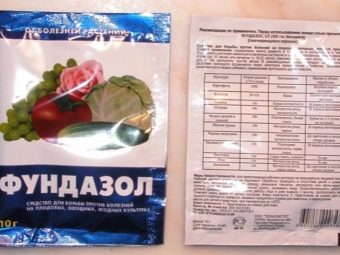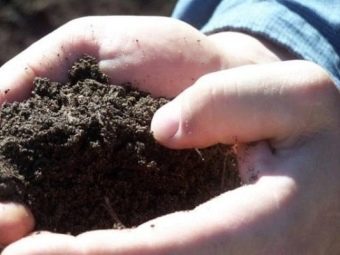How to feed strawberries in spring and how to do it right?
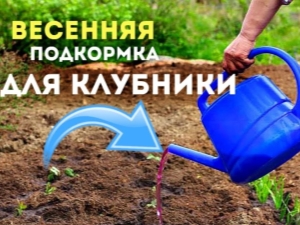
Spring can be called a creative season for gardeners and gardeners. It was during this period that people plan future plantings, pick up a variety of flowers and varieties of vegetables. In spring, the land is still completely clean - it does not have time to grow weeds, but perennial fruit and berry crops are beginning to slowly wake up. One of them is everyone's favorite strawberry.
At the very beginning of the season it is necessary to feed it, so that later it gives big and juicy berries.
The need and types of spring dressings
Top dressing strawberries in spring is a necessary procedure that contributes to obtaining a rich harvest. The required nutrients contribute to this culture in the growth and formation of kidneys. However, it is important not to overdo it by adding feedings. This can adversely affect the growth and development of the bush. Excess fertilizer will provoke too active growth of the bush itself, but will not affect the development of fruits and ovaries.
There are two main options for feeding strawberries in the spring season.
- Root. Root methods involve the addition of fertilizers directly to the soil, as close as possible to the rhizomes. This option is addressed very often. At the same time, nutrients should be poured at a minimum distance from the bush and buried to a depth of about 9 cm. It is also permissible to add fertilizing right under the root of the strawberry. In the above case, the top layer of soil should be no more than 2 cm. For the initial feeding, which is done when growing greens, as well as during laying buds it is permissible to use ordinary chicken manure. An alternative to litter will be manure.
- Foliar. When using foliar nutrition, nutrients can be supplied not only through the root system, but also through the leaflets. A similar way of feeding strawberries is a simple spraying. They can process plants using both organic and minerals.
How to fertilize the plant after winter?
With the arrival of spring, many gardeners are wondering what exactly is possible to fertilize strawberries so that in the future it will give a big and healthy harvest. It is worth considering what tools are suitable for such procedures.
Mineral components
Today, on the shelves of stores most often there are three nitrogen-containing fertilizers, which are inexpensive and have a modest consumption.
Urea
This popular fertilizer contains the largest percentage of nitrogen — 46%. The remaining urea composition is occupied by oxygen, hydrogen, and carbon. This type of fertilizer, in contact with air, forms ammonia, which quickly evaporates. That is why urea is required or embedded in the ground, or introduced in the form of a mixture. The specified fertilizer is characterized by a weakly acid reaction, which is rather close to neutral, which is why it is allowed to apply in the case of any kind of soil.
Ammonium nitrate
This fertilizer is a salt of nitric acid, the content of which contains 35% of nitrogen. The main disadvantage of this tool lies in the fact that it significantly increases the level of acidity of the soil. For this reason, it is permissible to bring it along with special dolomite flour. However, the same tool is great in combating a variety of plant diseases.
Watering the earth and leaves with a solution of ammonium nitrate, you can easily say goodbye to fungi.
Nitroammofosk
This fertilizer is complex. It contains the three most important elements - phosphorus, nitrogen and potassium. Many manufacturers today produce a variety of brands of this mixture, which differ from each other by the specific ratio of available microelements. Minus nitroammofoska lies in the fact that it is permissible to carry it into the spring season only if the plantings were not fed before the fall (in the fall) with superphosphate or potassium salt.
How and to what extent you need to add mineral fertilizers, usually indicated on the package. However, experts recommend making a little less of these components, because, for example, excess nitrogen can accumulate in the leaves of strawberries, and then in the berries themselves in the form of nitrates. Nitrates do not have a detrimental effect on human health, but in some circumstances in the body they can become poisonous. As a rule, this takes place in case of decrease in the level of acidity, with gastritis and neglect of hygiene. Children and older people are more sensitive to nitrates. For this reason, old people and children are encouraged to eat fruit and fruit juices that were grown without the use of various chemicals.
Organics
If you do not want to use chemical mineral fertilizers, then you should turn to organic products. These include several options.
Mullein
Otherwise, this fertilizer is called manure. From it you can prepare a good nitrogen fertilizer. Korovyak is litter and bespattering. Nitrogen dressing is especially necessary in the spring, so it is best to give preference to a bespattering mullein, which is pure manure with a nitrogen content of 60–70%.
In this case, it is permissible to use ordinary cow pellets (they can be found in places where cows usually graze).
Bird droppings
Very often for feeding strawberries people turn to bird droppings. Such a tool is rightly recognized as the most spectacular organic fertilizer. It contains a very high content of useful substances (many times more than in other compositions). In the litter there are components such as nitrogen, phosphorus, potassium and other necessary elements. Prepare such a tool can be independently or purchased in the store, but on the shelves are usually found dried products. In addition, it may not be chicken droppings at all, but humus.
Humus
Many gardeners are turning to this fertilizer. It is a rotten waste of both animal and vegetable origin. Often, ordinary manure is called humus, which has lain for about 1–2 years. However, this category should also include compost, rotten litter, and even a layer of rotten foliage lying under the trees.
In such fertilizers there is an impressive percentage of nitrogen.
Wood ash
It is a fertilizer, which makes no sense to add in the spring, not backed up with nitrogen fertilizer (for this you can use urea, mullein or bird droppings). The composition of wood ash contains all the trace elements that are required strawberries, not only nitrogen. If one applies to simultaneous application with nitrogen-containing agents, an undesirable reaction may occur. Ash is alkali, and nitrogen in the company with it becomes ammonia and evaporates. To get the ashes, it is permissible not only to burn firewood, but also a wide variety of vegetation residues. For example, it may be dried grass, tops or leaves from last year.
Folk remedies
Many gardeners refuse to use organic or mineral fertilizers in favor of the old old-fashioned methods, in which they use various folk remedies. It is worth considering the most popular ones.
- Yeast. They contribute to the rapid decomposition of organic matter in the soil, that is, they change its shape, which becomes available for feeding plants. In addition, this folk remedy has a positive effect on the formation of roots. As you know, the stronger the roots, the more impressive the bush will be, and the fruits on it will grow large. Yeast needs to be entered only in rather warm soil as the ideal temperature for their decomposition is the indicator in +20 degrees.While the yeast is wandering, a lot of calcium and potassium is absorbed from the ground, which is why immediately after being treated with a yeast compound, it is necessary to turn to the application of ash feeding.
- Nettle. A good tool is an infusion of nettle. Many gardeners and gardeners also turn to this folk remedy. Thanks to this tool, the yield of strawberries is significantly increased. As part of nettle tincture there is a sufficient amount of nutrients that can make the plant stronger and healthier.
- Serum. It is permissible to refer to the so-called fermented milk dressing, in which they use whey. This tool will not only increase the yield of strawberries, but also contribute to the healthy development of the plant. Often, serum is applied along with humus or ash in order to increase the effect. Such supplements can also boast health and preventive properties.
Garden "chemistry"
Often gardeners turn to affordable and prevalent garden "chemistry", which can be purchased at any pharmacy. Such tools are very popular because they have high efficiency.
- Ammonia. Few people know, but the feeding of strawberries in the spring can be done with the use of ammonia. It can be found in any pharmacy. Ammonia is a highly effective agent, since it contains a nitrogen compound such as ammonia. Moreover, it is worth mentioning that ammonia has a sharp smell, which will drive away various pests from strawberries. And also this affordable remedy has a disinfecting effect and literally destroys fungi, which are often located on strawberry leaves.
- Iodine. This component, which is found in many components of wildlife. He is in the water, in the air, and in the ground, but in small quantities. There is this component in all living organisms, plants are no exceptions. Many gardeners acquire such a tool as alcohol-containing iodine, which can be found in almost any pharmacy. It is believed that this antiseptic effectively protects plants from various diseases, and after entering the soil it becomes a catalyst for nitrogen metabolism.
- Boric acid. With this feeding strawberry bushes will not only give a richer harvest, but also become resistant to bad weather conditions. Turning to boric acid, it is possible to ensure that the strawberries grow more dense and sweet, but will not crack from moisture. Most effectively this dressing works in conditions of peat and sod-podzolic lands.
How to feed young and adult bushes?
Berry, which was planted last year, does not require additional feeding in the spring, if the required amount of organic and mineral fertilizers were added to the soil during planting. If there are any doubts about the literacy of fertilizer in the past year, it is better to turn to the appropriate means for this. For example, it is permissible to add chicken manure or sodium sulfate solution. Fertilizers must be applied directly to the soil cleaned beforehand from any litter. If you want to buy a tool in the store, then you should pick it up in accordance with the type of soil that is available on the site. In addition, it is very important to study in detail the instructions for using the product, which is usually present on the package.
As for an adult strawberry, it needs regular feeding, since the soil becomes poorer over time. Of course, it is permissible not to engage in such gardening work, so as not to encounter unnecessary trouble, but in such conditions it makes no sense to expect a lush harvest. If, however, you still want to get as a result of juicy and sweet fruits, you will need to fertilize the crop several times, namely:
- 1 time - after the formation of "starting" 2-3 leaves;
- 2 times - in the course of tying berries.
Important! When reaching 2 or 4 years old, it is advisable to “feed” strawberries in the spring with organic or mineral products. And on the 3rd year of disembarkation, only mineral ones can be put into action
Fertilizer application rules and steps
There are no specific deadlines for fertilization - it all depends on the climate. But if there is an opportunity, then it is worthwhile to start planting fertilizer early. If the summer cottage is located far from the host city, then it is possible to visit it at the end of winter. In such a situation, it is permissible to start feeding when it is still snowing. Pellets scatter on the melting snow. They will dissolve in the aquatic environment and go to the roots through the soil. Ideally, mineral options or ash will do.
If it is possible to visit the site only in dry land conditions, then fertilizer should be added simultaneously with loosening. They are also scattered on the beds and mixed with the ground. Next, the watering is done. Otherwise, it is allowed to apply initially liquid feedings. Top dressing of strawberry is carried out in such main stages as:
- spring fertilizer is carried out;
- fertilizer is made after harvest;
- fertilizer is applied in summer or autumn.
Of course, this plan is not the only correct one. In any case, it is necessary to take into account the peculiarities of the plant that is planted on the site. It is worth remembering that in the event of a glut of strawberries in the spring, the harvest will not be rich, but modest. Excess amount of top dressing will have a beneficial effect on the growth of the green part of the bush, and may even lead to the fact that it gets sick. This is due to the fact that the landing will have to "compete" with the trace elements. At the same time the immunity of strawberries will decrease.
Feed scheme looks like this:
- early spring - the beds are cleaned from excess leaves, after which all the bushes are watered with a fertilizer in a liquid consistency;
- budding period - it is necessary to fertilize strawberries 2 times, keeping a pause per week;
- from July to August - when the crop is already harvested, you will need to fertilize the plant and remove the old leaves;
- September - fertilizing will be needed to prepare for the cold season.
In the process of flowering strawberries still need proper feeding. When the first sweet fruits appear, the potassium is especially needed for the plant. After the formation of berries, between the rows it is necessary to pour or pour wood ash - 1 handful under a bush or 0.5 liquid composition. To prepare a suitable liquid solution, you will need to take 2 cups of wood ash, and then insist in boiling water for at least 3 hours. After that, the composition should be poured 10 liters of warm water. Other mineral remedies must be diluted in accordance with the instructions. Experiments should not be conducted so as not to harm the landings.
Berry fruits for 2-3 weeks in accordance with its specific variety. During this period, it is also necessary to fertilize the plant. According to experts, mullein fertilizer is considered to be a universal fertilizer diluted with water in a ratio of 1: 15. A similar composition means if you add not manure, but chicken manure in a ratio of 1:10. but they are recommended to alternate.
When the harvest is gathered, it is necessary to burst, water and fertilize the bushes. At these moments rhizomes, green beds, and also buds are set up for the coming season. This year will need to mow the leaves of the bushes. It is best done at the end of fruiting - do not waste time in vain. Otherwise, the plant simply will not be able to "gain strength" for the season.
Common mistakes
It is necessary to consider a few of the most common mistakes that summer residents make when they feed strawberries.
These include the following:
- apply too much or too little fertilizer;
- root dressings in the form of organic additives are placed under the stem, contacting with leaves;
- Strawberry fertilizers are engaged in special nitrogenous means when the temperature in the yard is less than +15 degrees.
Important! You should try not to encounter such omissions, otherwise you will not achieve a good harvest. In addition, you should try not to experiment and follow the instructions, if you use the purchase of fertilizer.
Useful tips
It is worth adhering to a few tips from experienced gardeners.
- If the planted plants become victims of the fungus, then you can turn to special preparations, which include a high content of copper. It can be such means as "Topaz" or "Fundazol". But we must not forget that the care of plants with these compounds is harmful to human health.
- Do not plant strawberry seedlings with leaves. To large and overgrown leaves did not begin to drain the plant, they must be removed. You can leave only 2 of the youngest leaf.
- Of course, everyone wants to grow strawberries without resorting to chemical means. However, this plant simply can not do without treatment from pests. But it should be borne in mind that processing is permissible to produce only after the collection of fruits, as well as before flowering.
- If for a long time only organic fertilizers were used for feeding strawberry bushes, then it is better not to use chemical fertilizers.
- It is worth a little to heal the earth before using organic supplements. Active microorganisms can be very useful here.
How to feed strawberries in the spring, see the next video.



